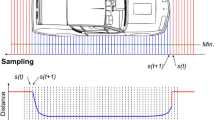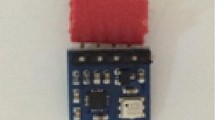Abstract
In this paper, a novel region-based approach for estimating the speed of a vehicle using wireless sensor networks is presented. Compared with a point-based approach, which is used to determine the vehicle arrival and departure points separately in each node, the proposed region-based approach is used to determine the speed of a vehicle at the server using the similarities among the sensor data received from two sensor nodes. In the proposed approach, a moving-average filter is applied to reduce noise in the sensor reading. Next, N-samples of data around a feature point with a first-order derivative larger than the chosen threshold are recorded. Delta coding is then applied to compress the data and minimize the power consumption required for communication from the sensor nodes to the server. Finally, the similarity of the data received from the two sensor nodes is measured to estimate the speed of the vehicle. More specifically, a similarity measure, a modified version of a cross-correlation function, is proposed. In addition, an evolutionary programming technique is adopted to find the optimal parameters for the threshold value of the first-order derivative and the number of samples that need to be sent to the server. Experimental results are provided to show the effectiveness of the proposed region-based vehicle speed estimation approach.








Similar content being viewed by others
References
Gajda et al J (2001) A vehicle classification based on inductive loop detectors. In: Proceedings of IEEE International Conference on Instrumentation and Measurement Technology, pp 21–23
Xuan Y et al (2005) A high-range-resolution microwave radar system for traffic flow rate measurement. In: Proceedings of Intelligent Transportation Systems, pp 880–885
Iwasaki (2008) A method of robust moving vehicle detection for bad weather using an infrared thermography camera. In: Proceedings Of ICWAPR ’08, pp 86–90
Choi KH et al (2014) State machine and Downhill simplex approach for vision-based nighttime vehicle detection. ETRI J 36(3):439–449
Park HS et al (2013) In-vehicle AR-HUD system to provide driving-safety information. ETRI J 35(6):1038–1047
Tubaishat M et al (2009) Wireless Sensor networks in intelligent transportation systems. Wirel Commun Mobile Comput 9:287–302
Kim DH et al (2009) A feasibility study on crash avoidance at four-way stop-sign-controlled intersections using wireless sensor networks. IEICE Trans 95:1190–1193
Karpiriski M, Senart A, Cahill V (2006) Sensor networks for smart roads. In: Proceedings of IEEE International Conference on Pervasive Computing and Communications, pp 1–5
Chen W et al (2006) WITS: a wireless sensor network for intelligent transportation system. In: Proceedings of IMSCCS, pp 635–641
Yu T, Bo G, Ling T (2008) Design and application of wireless sensor networks for ground verification of remote sensing. In: Proceedings of international conference on apperceiving computing and intelligence analysis, pp 381–384
Cheung SY, Varaiya P (2007) Traffic surveillance by wireless sensor networks: final report. In: California PATH Research Report UCB-ITS-PRR-2007-4
Yoo JJ, Kim DH, Park JH (2010) Design and implementation of magnetic sensor network for detecting automobiles. In: Proceedings of IEEE 35th Conference on local computer networks, pp 929–932
Scarzello J, Usher G (1979) A low power magnetometer for vehicle detection. IEEE Trans Magn 13:1101–1103
Christou CT, Jacyna GM (2010) Vehicle detection and localization using unattended ground magnetometer sensors. In: Proceedings of 13th Conference on Information Fusion (FUSION), pp 1–8
Ding J et al (2004) Signal processing of sensor node data for vehicle detection. In: Proceedings of IEEE International Conference on Intelligent Transportation Systems, pp 70–75
Pelegri J, Alberola J, Llario V (2002) Vehicle detection and car speed monitoring system using GMR magnetic sensors. In: Proceedings of IEEE 28th Annual Conference of the Industrial Electronics, pp 1693–1695
Zhang L et al (2010) Piezoelectric detection device and experimental analysis of automobile wheelbase difference. In: Proceedings of the 2nd international conference on Signal Processing Systems (ICSPS), pp V1-407–V1-410
Knaian AN (2000) A wireless sensor network for roadbeds and intelligent transportation systems. MS thesis at the Electrical Engineering and Computer Science, MIT
Zhang y, Huang X, Cui L (2007) Lightweight signal processing in sensor node for real-time traffic monitoring. In: Proceedings of IEEE International Symposium on Communications and Information Technologies, pp 1407–1412
Nan D et al (2008) Low-power vehicle speed estimation algorithm based on WSN. In: Proceedings of 11th IEEE Conference on Intelligent Transportation Systems, pp 1015–1020
Franceschinis M et al (2009) Wireless sensor networks for intelligent transportation systems. In: Proceedings of IEEE Vehicular Technology Conference, pp 1–5
Kwong K et al (2010) Real-time measurement of link vehicle count and travel time in a road network. IEEE Trans Intell Transp Syst 11(4):814–825
Sifuentes E, Casas O, Pallas-Areny R (2011) Wireless magnetic sensor node for vehicle detection with optical wake-up. Sensors J IEEE 11(8):1669–1676
Guan X et al (2013) A vehicle detection algorithm based on wireless magnetic sensor networks. In: Proceedings International ICST Conference onCommunications and Networking, pp 669–674
Zhang Q et al (2013) Wireless magnetic sensor node for vehicle detection using finite element simulation. In: Proceedings of IEEE International Conference onInformation and Automation (ICIA), pp 248–251
Welch TA (1984) A technique for high-performance data compression. Computer 17(6):8–19
Aquino JFS et al (2008) A differential coding algorithm for wireless sensor networks. In: Proceedings of IEEE International Symposium on Personal, Indoor and Mobile Radio Communications, pp 1–5
Marcelloni F, Vecchio M (2008) A simple algorithm for data compression in wireless sensor networks. IEEE Commun Lett 12(6):411–413
Skordylis A, Guitton A, Trigoni N (2006) Correlation-based data dissemination in traffic monitoring sensor networks. In: Proceedings of the 2006 ACM CoNEXT Conference
Byl AV, Neilson R, Wilkinson RH (2009) An evaluation of compression techniques for wireless sensor networks. In: Proceedings of AFRICON, pp 1–6
Capo-Chichi MEO, Friedt JM, Guyennet H (2010) Data compression for delay constrained applications in wireless sensor networks. In: Proceedings of SENSORCOMM, pp 101–107
Reindardt A, Hollick M, Steinmetz R (2009) Stream-oriented lossless packet compression in wireless sensor networks. In: Proceedings of SECON, pp 1–9
Taghanaki SA et al (2012) Nonlinear feature transformation and genetic feature selection: improving system security and decreasing computational cost. ETRI J 34(6):847–857
Sara GS et al (2012) A genetic-algorithm-based optimized clustering for energy-efficient routing in MWSN. ETRI J 34(6):922–931
Acknowledgments
This work was supported by the Ministry of Science, ICT and Future Planning/Korea Research Council for Industrial Science and Technology under an intelligent situation cognition and IoT basic technology development project “The Development of Wireless Automotive Sensor Networks Technology and Smart Vehicle”.
Author information
Authors and Affiliations
Corresponding author
Rights and permissions
About this article
Cite this article
Kim, DH., Choi, KH., Li, KJ. et al. Performance of vehicle speed estimation using wireless sensor networks: a region-based approach. J Supercomput 71, 2101–2120 (2015). https://doi.org/10.1007/s11227-014-1306-7
Published:
Issue Date:
DOI: https://doi.org/10.1007/s11227-014-1306-7




